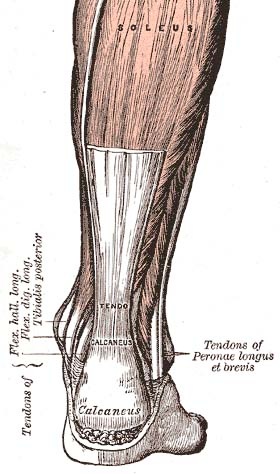Common Injuries: Achilles Tendonitis
Does this sound familiar: You’ve stepped up your training schedule for the next 5K or half marathon, determined to break your last time, but now you’re in pain. Your first few steps in the morning are down right excruciating. Your ankles are stiff and taking longer to get warmed up than they used to. Or maybe you just got a sweet new pair of kicks, and having pain breaking them in. Don’t worry, you don’t have to hang it up for the season! You might have Achilles tendonitis, a common plague for athletes of all kinds.
What is this “Achilles” you speak of?
The Achilles tendon is the common tendon that connects the two heads of the gastronemius(calf muscle), and the soleus muscle to the heel bone, also called the calcaneus. Primarily serving to bend the ankle, the gastroc and Achilles tendon are stressed more in activities that involve a lot of pushing off from the toe. In running, that’s every single stride you make to propel your body forward. When there is increased load to do so, more strain is put on the muscle, and therefore the tendon. In fact, running can add forces up to 10 times an individual’s body weight within the tendon!1 What results is pain, tenderness, and maybe even thickening or nodules forming on the tendon itself.

Acutely, Achilles tendonitis can sneak up on you when making a change in your training program - be that distance, speed or incline. Others are so blessed to have it as a recurring issue. This is when you might see thickening of the tendon on one or both sides, or firm nodules forming within the tendon itself. This is a result of inflammation - your body’s reaction to stress, its a coping mechanism. While resting or literally taking a load off will help, you don’t want to loose valuable time. And if that race date is coming up, that is even more true.
Using Acupuncture as Treatment
If this is a recurring problem for you, you may have already consulted your doctor or gone through a round of physical therapy. This can be very helpful to address the biomechanics of your stride and muscle imbalance. Tendons, having less blood supply than muscles, are harder to heal on their own.
But, you might not have thought to use acupuncture. As a specialist in acupuncture for orthopedics and sports injuries, I’ve got a couple tricks to tell you about. Firstly, you can’t treat the tendon without treating the surrounding muscle. I look for tight tender points in the muscle belly of the calf, as well as the smaller muscles of the lower leg. These muscles assist in ankle movement, and flexion of the toes. Also known as trigger points, these are places in the muscle where the tissue is contracted and inflamed. Looking further up the chain, I also look at the hip and low back, and address any issues there.
The other way acupuncture can help is by bringing more blood flow to an area of the body that naturally has less blood supply. With acupuncture needles, we can actually surround the tendon, and use electricity that feels similar to a TENS unit, to vastly increase the circulation to the tendon. In some cases of Achilles tendonitis, new blood vessels have formed around the back of the tendon in an effort to increase blood flow.2 Research is ongoing to determine what role this may play in diagnosing and treating Achilles pathologies.
The take home message is that Achilles tendonitis can be a very manageable condition with a comprehensive treatment plan. In addition to a great home exercise program and the right pair of shoes, acupuncture can be a wonderful complementary piece of the puzzle. Reduce pain, speed up the healing process, and crush it out there on the road.
1 Reaves, Whitfield. The Acupuncture Handbook of Sports Injuries and Pain. 3rd ed. Boulder, CO: Hidden Needle, 2013. Print.
2 Knobloch, Karsten. The Role of Tendon Microcirculation in Achilles and Patellar Tendinopathy. Journal of Orthopaedic Surgery and Research, 30 Apr. 2008. Web. 03 May 2016.
Illustration: Gray’s Anatomy
 Suzanne received her undergraduate degree in dance from Muhlenberg College in Allentown, Pennsylvania. Thereafter she obtained her Masters of Science in Oriental Medicine in 2012 here in Portland, Oregon from the National College of Natural Medicine. She is certified by the National Certification Commission for Acupuncture and Oriental Medicine as a Diplomate of Acupuncture. After she received licensure, she completed an apprenticeship training program through Whitfield Reave’s Acupuncture for Sports Medicine in acupuncture techniques for orthopedics and sports medicine. She enjoys combining the holistic approach of Chinese medicine with the knowledge of western orthopedics to benefit patients with musculoskeletal problems of all kinds. In addition to musculoskeletal injuries, she enjoys working with patients to address overall wellness concerns, headaches, and women’s health issues.
Suzanne received her undergraduate degree in dance from Muhlenberg College in Allentown, Pennsylvania. Thereafter she obtained her Masters of Science in Oriental Medicine in 2012 here in Portland, Oregon from the National College of Natural Medicine. She is certified by the National Certification Commission for Acupuncture and Oriental Medicine as a Diplomate of Acupuncture. After she received licensure, she completed an apprenticeship training program through Whitfield Reave’s Acupuncture for Sports Medicine in acupuncture techniques for orthopedics and sports medicine. She enjoys combining the holistic approach of Chinese medicine with the knowledge of western orthopedics to benefit patients with musculoskeletal problems of all kinds. In addition to musculoskeletal injuries, she enjoys working with patients to address overall wellness concerns, headaches, and women’s health issues.
Outside the clinic, Suzanne can most likely be found in the dance or yoga studio. She continues to pursue a professional career in contemporary dance, performing as a freelancer and with Muddy Feet Contemporary Dance. She and her husband enjoy attending the Portland Timbers matches, even getting their dog Timber Rosie pumped up for the games.
Suzanne practices inside Rose City Physical Therapy under her own entity. The relationship with likeminded professionals and patients fosters a complementary environment. You can learn more of Suzanne on her website by clicking here. In addition to calling Rose City Physical Therapy to schedule an appointment to see Suzanne, she also offers online scheduling on her website.
Connect With Us
see the latest from Fleet Feet PDX